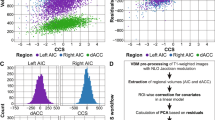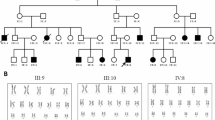Abstract
Molecular karyotyping is being increasingly applied to delineate novel disease causing microaberrations and related syndromes in patients with mental retardation of unknown aetiology. We report on three unrelated patients with overlapping de novo interstitial microdeletions involving 5q14.3-q15. All three patients presented with severe psychomotor retardation, epilepsy or febrile seizures, muscular hypotonia and variable brain and minor anomalies. Molecular karyotyping revealed three overlapping microdeletions measuring 5.7, 3.9 and 3.6 Mb, respectively. The microdeletions were identified using single nucleotide polymorphism (SNP) arrays (Affymetrix 100K and Illumina 550K) and array comparative genomic hybridization (1 Mb Sanger array-CGH). Confirmation and segregation studies were performed using fluorescence in situ hybridization (FISH) and quantitative PCR. All three aberrations were confirmed and proven to have occurred de novo. The boundaries and sizes of the deletions in the three patients were different, but an overlapping region of around 1.6 Mb in 5q14.3 was defined. It included five genes: CETN3, AC093510.2, POLR3G, LYSMD3 and the proximal part of GPR98/MASS1, a known epilepsy gene. Haploinsufficiency of GPR98/MASS1 is probably responsible for the seizure phenotype in our patients. At least one other gene contained in the commonly deleted region, LYSMD3, shows a high level of central nervous expression during embryogenesis and is also, therefore, a good candidate gene for other central nervous system (CNS) symptoms, such as psychomotor retardation, brain anomalies and muscular hypotonia of the 5q14.3 microdeletion syndrome.
Similar content being viewed by others
Log in or create a free account to read this content
Gain free access to this article, as well as selected content from this journal and more on nature.com
or
References
Menten B, Maas N, Thienpont B et al: Emerging patterns of cryptic chromosomal imbalance in patients with idiopathic mental retardation and multiple congenital anomalies: a new series of 140 patients and review of published reports. J Med Genet 2006; 43: 625–633.
Engels H, Brockschmidt A, Hoischen A et al: DNA microarray analysis identifies candidate regions and genes in unexplained mental retardation. Neurology 2007; 68: 743–750.
Hoyer J, Dreweke A, Becker C et al: Molecular karyotyping in patients with mental retardation using 100K single-nucleotide polymorphism arrays. J Med Genet 2007; 44: 629–636.
Redon R, Ishikawa S, Fitch KR et al: Global variation in copy number in the human genome. Nature 2006; 444: 444–454.
Mefford HC, Sharp AJ, Baker C et al: Recurrent rearrangements of chromosome 1q21.1 and variable pediatric phenotypes. N Engl J Med 2008; 359: 1685–1699.
Uhrig S, Schlembach D, Waldispuehl-Geigl J et al: Impact of array comparative genomic hybridization-derived information on genetic counseling demonstrated by prenatal diagnosis of the TAR (thrombocytopenia-absent-radius) syndrome-associated microdeletion 1q21.1. Am J Hum Genet 2007; 81: 866–868.
Shaffer LG, Theisen A, Bejjani BA et al: The discovery of microdeletion syndromes in the post-genomic era: review of the methodology and characterization of a new 1q41q42 microdeletion syndrome. Genet Med 2007; 9: 607–616.
Rajcan-Separovic E, Harvard C, Liu X et al: Clinical and molecular cytogenetic characterisation of a newly recognised microdeletion syndrome involving 2p15-16.1. J Med Genet 2007; 44: 269–276.
Hannes FD, Sharp AJ, Mefford HC et al: Recurrent reciprocal deletions and duplications of 16p13.11: The deletion is a risk factor for MR/MCA while the duplication may be a rare benign variant. J Med Genet 2009; 46: 223–232.
Ullmann R, Turner G, Kirchhoff M et al: Array CGH identifies reciprocal 16p13.1 duplications and deletions that predispose to autism and/or mental retardation. Hum Mutat 2007; 28: 674–682.
Brockschmidt A, Todt U, Ryu S et al: Severe mental retardation with breathing abnormalities (Pitt-Hopkins syndrome) is caused by haploinsufficiency of the neuronal bHLH transcription factor TCF4. Hum Mol Genet 2007; 16: 1488–1494.
Zweier C, Peippo MM, Hoyer J et al: Haploinsufficiency of TCF4 causes syndromal mental retardation with intermittent hyperventilation (Pitt-Hopkins syndrome). Am J Hum Genet 2007; 80: 994–1001.
Amiel J, Rio M, de Pontual L et al: Mutations in TCF4, encoding a class I basic helix-loop-helix transcription factor, are responsible for Pitt-Hopkins syndrome, a severe epileptic encephalopathy associated with autonomic dysfunction. Am J Hum Genet 2007; 80: 988–993.
Koolen DA, Vissers LE, Pfundt R et al: A new chromosome 17q21.31 microdeletion syndrome associated with a common inversion polymorphism. Nat Genet 2006; 38: 999–1001.
Shaw-Smith C, Pittman AM, Willatt L et al: Microdeletion encompassing MAPT at chromosome 17q21.3 is associated with developmental delay and learning disability. Nat Genet 2006; 38: 1032–1037.
Sharp AJ, Hansen S, Selzer RR et al: Discovery of previously unidentified genomic disorders from the duplication architecture of the human genome. Nat Genet 2006; 38: 1038–1042.
Shaw-Smith C, Redon R, Rickman L et al: Microarray based comparative genomic hybridisation (array-CGH) detects submicroscopic chromosomal deletions and duplications in patients with learning disability/mental retardation and dysmorphic features. J Med Genet 2004; 41: 241–248.
Colella S, Yau C, Taylor JM et al: QuantiSNP: an Objective Bayes Hidden-Markov Model to detect and accurately map copy number variation using SNP genotyping data. Nucleic Acids Res 2007; 35: 2013–2025.
Lein ES, Hawrylycz MJ, Ao N et al: Genome-wide atlas of gene expression in the adult mouse brain. Nature 2007; 445: 168–176.
Gibert Y, McMillan DR, Kayes-Wandover K, Meyer A, Begemann G, White PC : Analysis of the very large G-protein coupled receptor gene (Vlgr1/Mass1/USH2C) in zebrafish. Gene 2005; 353: 200–206.
McMillan DR, Kayes-Wandover KM, Richardson JA, White PC : Very large G protein-coupled receptor-1, the largest known cell surface protein, is highly expressed in the developing central nervous system. J Biol Chem 2002; 277: 785–792.
Robinson R, Gardiner M : Molecular basis of Mendelian idiopathic epilepsies. Ann Med 2004; 36: 89–97.
Yagi H, Takamura Y, Yoneda T et al: Vlgr1 knockout mice show audiogenic seizure susceptibility. J Neurochem 2005; 92: 191–202.
Nakayama J, Fu YH, Clark AM et al: A nonsense mutation of the MASS1 gene in a family with febrile and afebrile seizures. Ann Neurol 2002; 52: 654–657.
Stemple DL, Solnica-Krezel L, Zwartkruis F et al: Mutations affecting development of the notochord in zebrafish. Development 1996; 123: 117–128.
Thisse B, Heyer V, Lux A et al: Spatial and temporal expression of the zebrafish genome by large-scale in situ hybridization screening. Methods Cell Biol 2004; 77: 505–519.
Sprague J, Bayraktaroglu L, Bradford Y et al: The Zebrafish Information Network: the zebrafish model organism database provides expanded support for genotypes and phenotypes. Nucleic Acids Res 2008; 36: D768–D772.
Xu J, Gong NL, Bodi I, Aronow BJ, Backx PH, Molkentin JD : Myocyte enhancer factors 2A and 2C induce dilated cardiomyopathy in transgenic mice. J Biol Chem 2006; 281: 9152–9162.
Naka H, Nakamura S, Shimazaki T, Okano H : Requirement for COUP-TFI and II in the temporal specification of neural stem cells in CNS development. Nat Neurosci 2008; 11: 1014–1023.
Eerola I, Boon LM, Mulliken JB et al: Capillary malformation-arteriovenous malformation, a new clinical and genetic disorder caused by RASA1 mutations. Am J Hum Genet 2003; 73: 1240–1249.
Acknowledgements
We thank the patients and their families for their kind cooperation. HE, AR, DW and UM are members of the ‘German Mental Retardation Network’ (MRNET) which is funded by the German Federal Ministry of Education and Research (BMBF) as a part of the National Genome Research Network (NGFNplus/www.ngfn.de/englisch/15.htm, project reference numbers 01GS08164, 01GS08160). HE was also supported by the BONFOR programme of the Medical Faculty of Rheinische Friedrich-Wilhelms-University, Bonn, Grant no. O-249.0004, and LW and HVF were supported by the Cambridge Biomedical Research centre. Data for this article were retrieved from the Zebrafish Information Network (ZFIN), University of Oregon, Eugene, OR 97403-5274; http://zfin.org/ and the Allen Mouse Brain Atlas; http://www.brain-map.org.
Author information
Authors and Affiliations
Corresponding author
Rights and permissions
About this article
Cite this article
Engels, H., Wohlleber, E., Zink, A. et al. A novel microdeletion syndrome involving 5q14.3-q15: clinical and molecular cytogenetic characterization of three patients. Eur J Hum Genet 17, 1592–1599 (2009). https://doi.org/10.1038/ejhg.2009.90
Received:
Revised:
Accepted:
Published:
Issue date:
DOI: https://doi.org/10.1038/ejhg.2009.90
Keywords
This article is cited by
-
Fins, fur, and wings: the study of Tmem161b across species, and what it tells us about its function in the heart
Mammalian Genome (2023)
-
Progress on the roles of MEF2C in neuropsychiatric diseases
Molecular Brain (2022)
-
Identification of a novel mutation in MEF2C gene in an atypical patient with frontotemporal lobar degeneration
Neurological Sciences (2022)
-
Novel MEF2C point mutations in Chinese patients with Rett (−like) syndrome or non-syndromic intellectual disability: insights into genotype-phenotype correlation
BMC Medical Genetics (2018)
-
The major depressive disorder GWAS-supported variant rs10514299 in TMEM161B-MEF2C predicts putamen activation during reward processing in alcohol dependence
Translational Psychiatry (2018)



